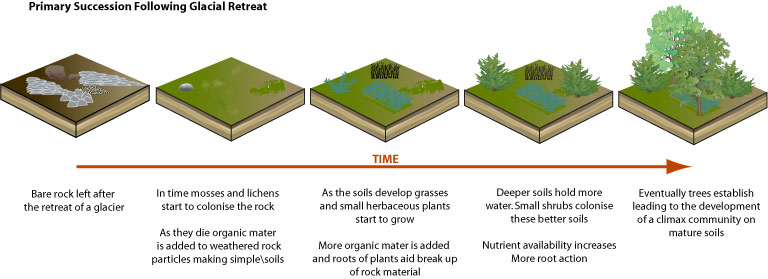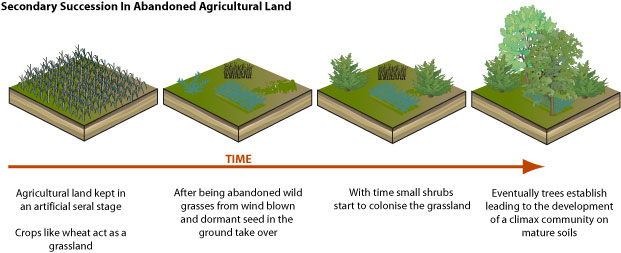E6. Communities are continually undergoing change.
Student Outcome: E6.1
Illustrate how community change may involve succession that leads over time to changes in the mixture of species.
- What is "ecological succession"?
"Ecological succession" is the observed process of change in the species structure of an ecological community over time. Within any community some species may become less abundant over some time interval, or they may even vanish from the ecosystem altogether. Similarly, over some time interval, other species within the community may become more abundant, or new species may even invade into the community from adjacent ecosystems. This observed change over time in what is living in a particular ecosystem is "ecological succession".
- Why does "ecological succession" occur?
Every species has a set of environmental conditions under which it will grow and reproduce most optimally. In a given ecosystem, and under that ecosystem's set of environmental conditions, those species that can grow the most efficiently and produce the most viable offspring will become the most abundant organisms. As long as the ecosystem's set of environmental conditions remains constant, those species optimally adapted to those conditions will flourish. The "engine" of succession, the cause of ecosystem change, is the impact of established species have upon their own environments. A consequence of living is the sometimes subtle and sometimes overt alteration of one's own environment. The original environment may have been optimal for the first species of plant or animal, but the newly altered environment is often optimal for some other species of plant or animal. Under the changed conditions of the environment, the previously dominant species may fail and another species may become ascendant.
Ecological succession may also occur when the conditions of an environment suddenly and drastically change. A forest fires, wind storms, and human activities like agriculture all greatly alter the conditions of an environment. These massive forces may also destroy species and thus alter the dynamics of the ecological community triggering a scramble for dominance among the species still present.
Source: http://www.nk2.psu.edu/naturetrail/succession.htm
Let's take the island of Krakatoa (in Indonesia) as an example.
- In the mid-1800's the island was dominated by tropical rainforest communities, highly complex in nature, and having the kind of tremendous diversity of plant and animal species that characterize those types of ecosystems.
- Then, in 1883 (at what is a oceanic crust-continental crust converging, and therefore, destructive, plate boundary--just to highlight the relevance of a topic covered earlier in this course) the entire island was shattered by a massive volcanic explosion. All life was obliterated. An abiotic (no living things were present) environment of hot ash and lava was left behind.
- But life began to re-colonize the island soon after the volcanic eruptions subsided.
The first scientific study of the recovery didn't take place until 1908.
Prior to that time the initial colonizers, probably algae, ferns, and grasses (as the primary producers), and small flying (or airborne, such as some spiders can be) insects (as consumers), and bacteria and fungi (as decomposers) had already reached the island and established new ecosystems. These initial ecosystems are known as pioneer communities. Their member species, both plants and animals, tend to be very hardy organisms that do well in exposed situations, and where there is limited competition from other, less hardy species that can't cope so well with the biologically impoverished and 'open' environments that characterize these types of communities.
- By 1908, however, these early pioneer communities had already largely been replaced by more complex communities, which are known as intermediate or seral stages of succession. The 1908 survey, for example, showed most of the island was covered by grassland or mixed forests, and counted 16 species of birds, 2 species of reptiles, and some 192 species of invertebrates (insects, etc.).
- By 1921 mixed forests dominated the island, and 47 species of birds, 5 of reptiles, 2 of mammals (bats), and more than 620 of insects were present. A more advanced or complex seral stage of succession had been achieved.
- By 1933 the forest started to include some species that are normally found in tropical rainforests, and more than 1100 species of animals (including invertebrates) of various kinds were present.
- In time--and this process may take some hundreds of years--if left undisturbed by further volcanic activity, the new island of Krakatoa is likely to support a complex tropical rainforest community, probably not greatly different from what occurred there prior to 1883.
This community, in that location, is termed a climax community, and represents (at least in theory) the 'end' stage of succession.
Ha. This video shows that even students have a sense of humour - and it's about Succession! Who would have thunk it!

Source: http://humanities.cqu.edu.au/geography/GEOG11023/week_12_textbook.htm
Comparison of plant, community, and ecosystem characteristics between early and late stages of succession
|
Attribute
|
Early Stages of Succession
|
Late Stages of Succession
|
|---|
| Plant Biomass |
Small
|
Large
|
| Plant Longevity |
Short
|
Long
|
| Seed Dispersal Characteristics of Dominant Plants |
Well dispersed
|
Poorly dispersed
|
| Plant Morphology and Physiology |
Simple
|
Complex
|
| Photosynthetic Efficiency of Dominant Plants at Low Light |
Low
|
High
|
| Rate of Soil Nutrient Resource Consumption by Plants |
Fast
|
Slow
|
| Plant Recovery Rate from Resource Limitation |
Fast
|
Slow
|
| Plant Leaf Canopy Structure |
Multilayered
|
Monolayer
|
| Site of Nutrient Storage |
Litter and Soil
|
Living Biomass and Litter
|
| Role of Decomposers in Cycling Nutrients to Plants |
Minor
|
Great
|
| Biogeochemical Cycling |
Open and Rapid
|
Closed and Slow
|
| Rate of Net Primary Productivity |
High
|
Low
|
| Community Site Characteristics |
Extreme
|
Moderate (Mesic)
|
| Importance of Macroenvironment on Plant Success |
Great
|
Moderate
|
| Ecosystem Stability |
Low
|
High
|
| Plant Species Diversity |
Low
|
High
|
| Life-History Type |
r
|
K
|
| Seed Longevity |
Long
|
Short
|
Source: http://www.physicalgeography.net/fundamentals/9i.html
Primary succession after glaciation:

Secondary succession after agricultural land use:

A good summary of an example of succession on sand dunes right here.
Another example of both primary and secondary succession - here we go!
A fairly dry example of succession in Alaska - try this! Note: the example plants are American in origin.
This is another example of how plant life has change in a volcanic island (Surtsey) off Iceland.
Student Outcome:E6.2
Explain why biodiversity is essential for the perpetuation of communities.
Conserving biodiversity has not always been high on the conservation agenda. In the past, most conservation efforts were focussed on saving a particular species from decline or extinction. Many conservationists argued that this was an effective way to not only protect endangered species, but to conserve biodiversity as well. This was because protecting an endangered species usually involved protecting that species' habitat and therefore all the other plants and animals in that habitat gained protection as well. This argument has some merit, because it is usually easier to gain support for the protection of one particular species than it is to convince people to support the conservation of biodiversity as a whole.
However, we now know that this approach is not the best way to conserve biodiversity. Areas we protect for a single species are not necessarily the areas we would protect if we were primarily interested in conserving biodiversity. There are a several reasons for this:
- If we only conserve areas because they are home to an endangered species, we may neglect some of the most important areas for biodiversity conservation.
- One of the three levels of biodiversity is ecosystem diversity, which is unlikely to be preserved if we only assess areas for preservation based on a single species.
- If we wait until a species is recognised as endangered before we preserve an ecosystem, the ecosystem may be so degraded that not only is the target species doomed but so are all the other unknown species that also inhabit that environment.
- Most conservation of a single species focuses on vertebrates or flowering plants whereas invertebrates, non-flowering plants, fungi and micro-organisms, which make up the bulk of species diversity in any ecosystem, tend to be ignored.
If we are genuine in our desire to conserve biodiversity, it is far more efficient to conserve whole ecosystems which encompass biodiversity at all levels, rather than focus on a few highly visible and popular species in isolation.
Source: http://www.amonline.net.au/factsheets/conserving_biodiversity.htm
This video is sort of on the topic but it shows how human activity affects diversity.

Comments (0)
You don't have permission to comment on this page.